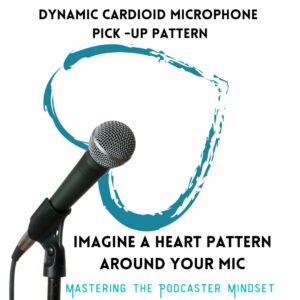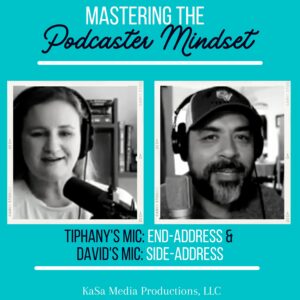Picking the Right Microphone for Your Podcast
By: Tiphany Kane, CEO KaSa Media Productions

Tiphany on the beautiful Blueberry mic by Blue (image: Greg Sais)
My partner, David Sais, is a professional audio and dialogue editor and is not a fan of the Yeti mic for home podcasters. Now don’t get me wrong, we love Blue microphones. The Blueberry is probably the most beautiful microphone ever (see my pic above and let me know how much you love this mic.) So I had a conversation with David to ask him…Why not the Yeti?
David: There are two reasons I’m not a fan of the Yeti for home podcasters. For one, it is a condenser microphone, and secondly, it’s confusing for many to use.
Tiphany: Ok- Let’s start with your first point- What is a condenser mic and why would a home podcaster not want one?
David: In order to better understand where I’m coming from, I should explain a bit about microphones in general. The two kinds of microphones you’ll hear people talk about are condenser and dynamic, with how they convert soundwaves to electrical signals being the difference between the two. Put very simply, a dynamic microphone uses permanent magnets, whereas a condenser uses power, or as I’m sure you’ve heard it referred to as phantom power to create those signals.
A dynamic mic functions in much the same way as any speaker does only in reverse with the movement of a coil in a magnetic field creating an electrical signal that gets sent through the wire to your recording device. A condenser, or capacitor mic if you’re in Europe, uses two plates referred to as a diaphragm and a backplate, that are very close together with air between them. Soundwaves cause the diaphragm to move, and it’s the air pulses that are created between the two plates that send the signal to your recording device.
Tiphany: That is interesting- now that we know the difference between the two types of mics, how does that affect the home podcaster?
David: The difference between a dynamic and a condenser microphone is due to their difference in sensitivity to sound. A dynamic microphone is commonly used for capturing loud, strong sounds (drums or loud vocals), particularly in a live setting, whereas a condenser microphone is used to capture more delicate sounds and higher frequencies (studio vocals for example), particularly in a studio setting. It is for those same reasons, you’ll find most radio broadcasters use dynamic microphones. They do a really great job at not picking up any background or room noises that might be happening while the person in front of the mic is recording. Unless you WANT to hear everything around you, such as in ASMR recordings, you’ll have a much easier time of getting a quiet recording with good dialogue isolation using a dynamic mic.
I would guess a good 80% or more of podcasts out today are recorded in that same podcast host’s home. It is rare that the space used for recording IN that home has been treated to deal with soundwave reflections and external noise entering the room.
The Yeti is a condenser microphone. This means it is the type of mic that is sensitive to picking up ALL sound, not just the sound coming from the voice of the person recording. I’ve done back-to-back tests in typical spaces where most home podcasters would be recording with the Yeti and similarly priced USB dynamic mics, and the dynamic mic was always the clearer of the two.
Tiphany: If I understand what you are saying, a dynamic mic won’t pick up all the room noise coming from the typical room where a home podcaster would be recording from. But a condenser mic, like the Yeti would pick up all the room sounds such as the a/c kicking on, the neighbor playing music next door, a car driving down the street, or your child getting something out of the fridge.
D: That is correct. A dynamic cardioid mic will reject noises that are not with the cardioid pattern. You can imagine a cardioid pick-up pattern looking like a heart around your mic. Sound will be picked up from the cardioid pattern and rejected from behind the pattern.

Imagine the dynamic cardioid pick-up pattern looking like a heart. (image by Tiphany Kane)
Tiphany: But some people already have a Yeti. What can they do if they don’t want to buy a new mic?
David: Start with where you are recording. The environment can actually be more important than your mic. Try recording in a soft space that will absorb reflections. make sure your space has pillows, blankets, carpet, etc. In fact, a walk-in closet, or even your kid’s dirty room will help to absorb sound bouncing off of hard surfaces. After that, read your instructions! Do this with any mic you buy.
The Yeti does have some useful features like its multiple pick-up patterns. But really, how many of you are planning on using any of the pickup patterns other than the little heart-shaped cardioid? One downside to the many pickup patterns, besides many people not knowing which one to choose for what they are recording, is what they did to the pop screen; the pop screen design is perhaps the cause of why I’ve seen so many people using it wrong. With it’s dome-like screen, many naturally think it’s an end-address microphone and talk into the top of it.
I’ve even seen a professionally produced commercial for a popular podcast recording platform that shows people using the Yeti as an end-address microphone. It is that confusing. If you own one, please don’t do this. It is a side-address microphone. This means when you are using it properly, you should be able to read the “Blue” logo. Set it on some books to pick it up to mouth level and try to record in a space like a walk-in closet with more soft surfaces than you think you need.

The Yeti is a side-address mic (image by: Tiphany Kane)
— — — — — — — — —
Tiphany Kane & David Sais are hosts of the podcast, Mastering the Podcaster Mindset. They also own a media production company, Kasa Media Productions. David specializes in helping clients get professional sound and Tiphany specializes in coaching podcasting clients. You can email us at [email protected] or follow us on Instagram @podcastermindet.




